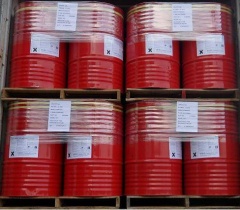Isocyanate
| Infobox on Isocyanate | |
|---|---|
| Example of Isocyanate |  |
| Facts | |
| Origin | - |
| Stowage factor (in m3/t) | - |
| Humidity / moisture | - |
| Ventilation | See text |
| Risk factors | See text |
Isocyanate
Description / Application
A compound containing the isocyanate radical – NCO. Monoisocyanates are in use, as in treatment of cellulose to obtain a cellulose tricarbamate, but the term isocyanate usually refers to a diisocyanate.
Diisocyanate is an organic compound with two iso-cyanate groups (-NCO) formed by treating diamines (e.g. toluene-2,4-diamine, hexamethylenediamine, p,p’-diaminodiphenylmethane) with phosgene. Combustible. It is used in the production of polyurethane foams and elastomers, in phenol-formaldehyde resins to improve water and alkali resistance, bonding rubber to rayon or nylon.
Shipment / Storage / Risk factors
Isocyanate is a brown liquid, having a slight musty odour.
Freezing/Melting point: <0ºC
Storage temperature: 16°C to 38°C
Boiling point: 208ºC
Decomposition temp.: >300ºC
Store in tightly closed containers (packages) to prevent moisture contamination. Do not reseal if contamination is suspected. Uncontaminated containers (packages), free of moisture, may be resealed only after placing under a nitrogen blanket. Do not store in containers (packages) made of copper, copper alloys or galvanized surfaces.
Exposure to vapours of heated isocyanates can be extremely dangerous.
For overseas carriage aspects of Chemicals, the readers are recommended to acquire or have access to a good chemical dictionary, and a copy of the International Maritime Dangerous Goods (IMDG) Code, issued by the International Maritime Organisation. Also consult the applicable MSDS sheet.











